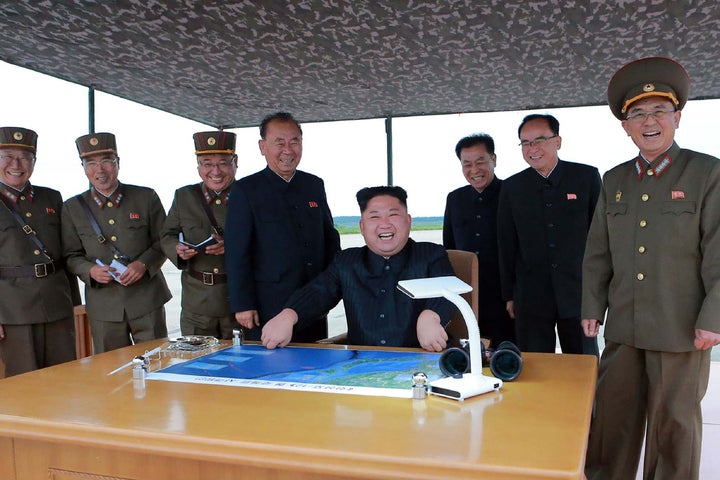North Korea on Tuesday fired an intermediate-range ballistic missile over Japan, causing the Japanese government to order its citizens to take shelter.
The incident highlighted just how short of a reaction time there is for governments and citizens following provocative missile launches, which for North Korea have become increasingly common.
It took around 15 minutes for North Korea’s missile to launch near the capital of Pyongyang, fly across Japan’s northern region of Hokkaido and finally split into fragments as it fell into the western Pacific, some 1,700 miles from its origin point. After about eight minutes, the missile had already reached Japan, the first time since 2009 that North Korea launched a projectile over the country.
In the brief timeframe immediately following such a missile launch, government analysts immediately try to determine where it is heading, what kind of payload it has and what the appropriate response should be ― including whether the use of missile defense systems is merited.
But experts say that despite the technology and resources devoted to monitoring missile launches, getting a precise picture quickly remains difficult and any potential attempt to shoot down a missile is fraught with complications.

Detecting A Launch
North Korean missile launches are initially detected by a series of radar systems, including ground and sea-based radar stationed in the region. The U.S. also has a space-based infrared system that can spot launches.
Based on information gleaned from radar systems, governments can determine whether a North Korean projectile is headed for a populated area.
“The bottom line is all of this is happening very quickly,” said Melissa Hanham, a nonproliferation expert at Middlebury Institute of International Studies (MIIS). “But within the first few minutes you should be able to tell it’s not aimed at Japan, it’s aimed over Japan.”
It’s impossible to ascertain a rocket’s exact path, however, and flawed predictions or failures about a missile’s flight can have potentially dire consequences.
“Trajectory estimates can be approximate and we’ve seen incorrect trajectory estimations in the past,” said Jeffrey Lewis, another nuclear nonproliferation expert at MIIS.
One of the most infamous incidents of misidentifying a projectile’s trajectory took place in 1995, when a Norwegian weather rocket nearly triggered a nuclear war. Russian radar detected Norway’s launch, but believed that it may have been a Trident ballistic missile headed toward Moscow.
Russia ultimately determined that the rocket was not a threat, but not before the Kremlin’s nuclear football was delivered to President Boris Yeltsin, who had minutes to decide whether to launch the country’s nuclear arsenal.

Weighing A Response
Some experts have pointed out the possibility that North Korea chose the flight path for the missile it fired on Tuesday in order to avoid the interpretation that it was launching an attack. Firing a missile over Tokyo, for instance, could potentially have sparked a military response.
Similarly, Defense Secretary James Mattis suggested earlier this month that the U.S. would shoot down any missile that was headed toward Guam, a U.S. territory.
Japanese military officials said after Tuesday’s launch that they didn’t use a missile defense system to try and shoot down the rocket because they quickly determined it was not a threat. But even if downing a missile is a desired goal, the rapid and sometimes imprecise calculations of where a projectile is headed make that a challenge.
“We imagine that we live in this universe in which we can see exactly where the missile is heading and so we know whether to shoot it down or not. But that’s something we imagine, not the world we actually live in,” Lewis said.
Missile defense systems in the region, like the Terminal High Altitude Area Defense, or THAAD, must also wait until the incoming projectile is within range before firing.
“THAAD can’t reach something a thousand kilometers away, it has to wait until it’s pretty close to take a shot,” said Laura Grego, a senior scientist at the Global Security Program at the Union of Concerned Scientists.
In the aftermath of the North Korea test over Japan, the international community is bracing for further tests and how to best respond.
The U.S. on Wednesday announced it had carried out a successful test of its missile defense system in Hawaii, knocking down the same range of ballistic missile that North Korea Korea fired days earlier. North Korea, meanwhile, stated via its official news agency that the launch over Japan was just a prelude to more action in the Pacific.
As regional governments prepare for the potential of more North Korean missile launches, states will have to decide whether to try and shoot down a projectile to test their own missile defense capabilities.
But such a decision comes with the threat of further escalating the situation ― or potentially failing to shoot down the missile.
“What’s the confidence that you’ll actually intercept it successfully?” Grego said. “If it’s going to drop in the ocean anyway and its not going to actually threaten your territory is it worth trying to intercept the missile to make a point?”
